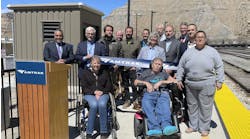Since October 2010, the Minnesota Valley Transit Authority (MVTA) has employed the use of a Driver Assist System (DAS) for bus-on-shoulder operations along Cedar Avenue (Trunk Highway 77). The DAS is a GPS-based guidance system that provides lane-position feedback to the bus driver via a head-up display (HUD), virtual mirror, vibrating seat, and actuated steering. MVTA’s primary goal for the DAS was to enhance driver confidence in the shoulders. Secondary goals included reducing travel times and increasing reliability, safety, and customer satisfaction.
This paper summarizes an evaluation of the Driver Assist System (DAS) used by the Minnesota Valley Transit Authority (MTVA) for bus shoulder operations. The DAS is a GPS-based technology suite that provides lane-position feedback to the driver via a head-up display, virtual mirror, vibrating seat and actuated steering.
MVTA’s primary goal was to enhance driver confidence, especially during adverse weather. Secondary goals included reduced travel times and increased reliability, safety and customer satisfaction. The evaluation used a “with and without” approach. Performance data were collected from the same drivers, with the DAS set to passive and then active mode. When the DAS was in active mode, the drivers stayed in the shoulders 10 percent longer and drove 3 miles per hour faster.
Lateral (side-to-side) movement was reduced by 5.5 inches. These results should be considered preliminary, as only 6 of the 25 trained drivers used the shoulders during both test periods. When surveyed, 32 percent of the bus drivers
said their level of confidence driving in the shoulder was greater when using the DAS, while 60 percent said it was the same. A majority believed the DAS made driving in the shoulder safer and less stressful. Nevertheless, many drivers
raised concerns about the head-up display being a distraction. By contrast, the vibrating seat was praised as the best feature of the entire system. For customer satisfaction, more than 80 percent of surveyed passengers rated the ride quality in the shoulder as very good or good.
FTA Report No. 0100 prepared by Brian Pessaro and Caleb Van Nostrand, National Bus Rapid Transit Institute (NBRTI), Center for Urban Transportation Research.


